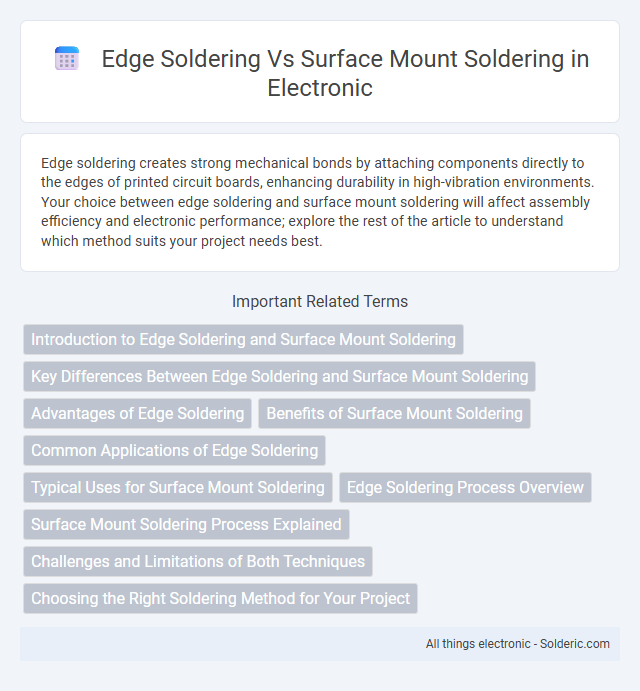Edge soldering creates strong mechanical bonds by attaching components directly to the edges of printed circuit boards, enhancing durability in high-vibration environments. Your choice between edge soldering and surface mount soldering will affect assembly efficiency and electronic performance; explore the rest of the article to understand which method suits your project needs best.
Comparison Table
| Aspect | Edge Soldering | Surface Mount Soldering |
|---|---|---|
| Definition | Soldering components located at the edge of the PCB. | Soldering components directly onto the PCB surface pads. |
| Components | Typically edge connectors, breakout boards. | SMT components like resistors, ICs, capacitors. |
| Process | Manual or wave soldering along PCB edges. | Reflow soldering using solder paste and ovens. |
| Precision | Lower precision, suitable for larger pads/connectors. | High precision, suitable for small and fine-pitch components. |
| Application | Edge connectors, expansion slots. | Most modern PCB assembly applications. |
| Reliability | Good mechanical strength for connectors. | Excellent electrical performance, sensitive to contamination. |
| Cost | Lower volume, often higher manual labor cost. | Optimized for mass production, lower per unit cost. |
Introduction to Edge Soldering and Surface Mount Soldering
Edge soldering involves attaching components to the edge of a printed circuit board (PCB) to enhance connectivity and mechanical strength, commonly used for connectors and card-edge applications. Surface mount soldering (SMT) places components directly onto the PCB surface using solder paste and reflow ovens, enabling high-density circuit designs and automated production. Both techniques optimize electrical performance and assembly efficiency but differ in application scope and component types.
Key Differences Between Edge Soldering and Surface Mount Soldering
Edge soldering involves attaching components to the edge of a PCB, providing robust mechanical support and efficient thermal dissipation ideal for connectors and LED strips. Surface mount soldering (SMT) places components directly onto the PCB surface, enabling high-density circuits and automated assembly with minimal drilling or through-hole requirements. The primary differences lie in component placement orientation, thermal management, and suitability for high-volume, compact electronics versus mechanically demanding applications.
Advantages of Edge Soldering
Edge soldering offers superior mechanical strength and enhanced thermal conductivity by securely connecting components along the PCB edge, ensuring robust electrical performance. This technique reduces thermal stress on sensitive components compared to surface mount soldering, leading to increased reliability and longevity of your electronic assemblies. Its precise alignment and efficient heat dissipation make edge soldering ideal for high-frequency and power applications.
Benefits of Surface Mount Soldering
Surface mount soldering offers significant benefits such as higher component density, enabling more compact and lightweight electronic designs. This method improves electrical performance by reducing lead lengths and parasitic inductance, which enhances signal integrity and device reliability. You can achieve faster automated assembly processes and lower production costs, making surface mount soldering ideal for modern manufacturing.
Common Applications of Edge Soldering
Edge soldering is commonly used in applications where connectors or components need a strong mechanical bond along the edge of a printed circuit board (PCB), such as in card-edge connectors and backplane assemblies. This technique is ideal for high-frequency or high-power devices requiring reliable edge connections, often found in telecommunications and industrial equipment. Your electronic designs benefit from edge soldering when durability and precise alignment of edge-mounted components are critical.
Typical Uses for Surface Mount Soldering
Surface mount soldering is primarily used in compact electronic devices like smartphones, laptops, and wearable technology due to its ability to support high-density circuit boards and small component packages. It allows for faster production speeds and automated assembly, making it ideal for mass manufacturing environments. Your electronic products benefit from enhanced reliability and performance when surface mount soldering is employed, especially in applications requiring lightweight and miniaturized components.
Edge Soldering Process Overview
Edge soldering targets the vertical edges of printed circuit boards (PCBs) to connect components mounted along the board's sides, often used for slot connectors and edge card connectors. This process involves applying solder paste or solder preforms to the PCB edge followed by controlled heating, ensuring reliable mechanical and electrical bonding without damaging nearby surface mount components. Precision temperature control and alignment are critical in edge soldering to prevent solder bridging and ensure strong, durable joints in high-density PCB assemblies.
Surface Mount Soldering Process Explained
Surface mount soldering involves attaching electronic components directly onto the surface of a printed circuit board (PCB) without using through-holes. This process typically uses solder paste applied via a stencil, precise component placement with automated machines, and reflow soldering where controlled heat melts the solder to create strong electrical and mechanical bonds. You benefit from the miniaturization and increased reliability offered by surface mount soldering in modern electronics manufacturing.
Challenges and Limitations of Both Techniques
Edge soldering faces alignment challenges due to limited contact area, leading to weaker mechanical bonds and increased risk of joint failure under stress. Surface mount soldering struggles with heat sensitivity of components and requires precise temperature control to prevent damage, complicating the manufacturing process. Your choice between these techniques should consider these limitations to ensure reliability and performance in electronic assemblies.
Choosing the Right Soldering Method for Your Project
Edge soldering provides strong mechanical bonds ideal for high-stress connections on circuit boards, whereas surface mount soldering excels in compact, high-density layouts due to its minimal footprint. Selecting the right soldering method depends on factors like component size, board design, thermal requirements, and production volume. Prioritize edge soldering for durability and surface mount for precision and space efficiency to optimize performance and reliability.
Edge soldering vs surface mount soldering Infographic

 solderic.com
solderic.com